The Pink Toe Tarantula is a unique pet spider. They make great first-time tarantulas because of their calm personality and simple care.
Tarantulas are scary for some people, but the Pink Toe is actually a shy and docile species itself.
Pink Toe Tarantulas are different in color and personality from most tarantulas. The obvious difference is their pink or orange colored toes. Most species are usually black or brown. They are also more docile and calmer than other spiders.
In this article we will cover everything you need to know about Pinktoes. From buying a young ‘sling’ spider, to their care, habitat, lifespan, molting and facts, we cover it all…
All About Pink Toe Tarantulas
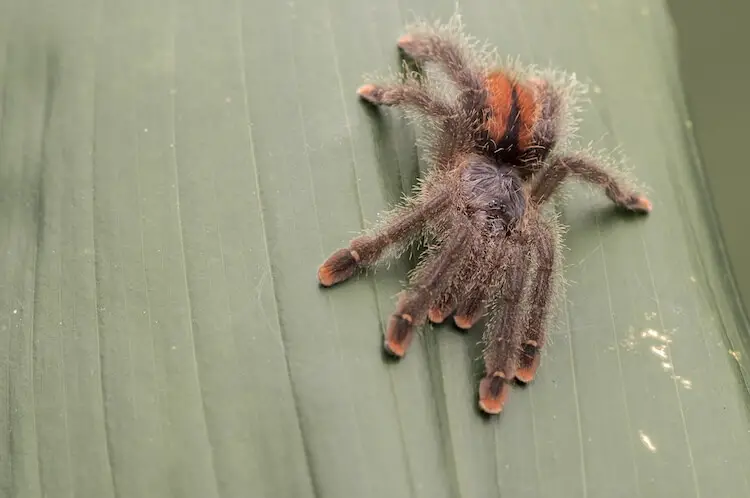
The Pink Toe Tarantula (Avicularia versicolor) is one of over 1,000 different Tarantula species in the family Theraphosidae.
Tarantulas in the family Theraphosidae are different from other spiders because they have many small hairs on the outside of their exoskeleton. Pink Toes can use these hairs as a defense mechanism. They can eject them from their abdomen causing their predators irritation.
Pink Toe Tarantulas are native to Central and South America, as well as several islands in the Southern Caribbean.
The Pink Toe was first described in 1758 by Carl Linneaus in South America.
Although Carl Linneaus first described the species, it is difficult to identify who was the first to keep pet tarantulas.
Their name comes from the tips of their legs which are peach colored and look like pink ‘toes’.
Tarantulas are generally hairy and come in just one color. But, the Pink Toe is unique due to their peach colored toes. This helps them blend into their shaded forest environment in South America.
They are a hardy and long lived species with most living up to 10 years. Some have even lived longer as pets. Females outgrow and outlive most males, they reach sizes of four to five inches, whereas males grow closer to 3.5 inches.
Pink Toes are a very popular pet spider. Their docile behavior has made them the most popular pet tarantula. It is a great pet due to their simple care needs and unique appearance.
They are cheap to feed and house and their enclosure does not need to be large.
What We Like
Pros
- Docile and not aggressive when compared to other tarantulas.
- Low-maintenance and simple care needs.
- Beautiful peach colored legs.
Cons
- Defensive hairs can irritate skin and prevent handling.
- Can have molting difficulties as pets.
Pink Toe Tarantula Care
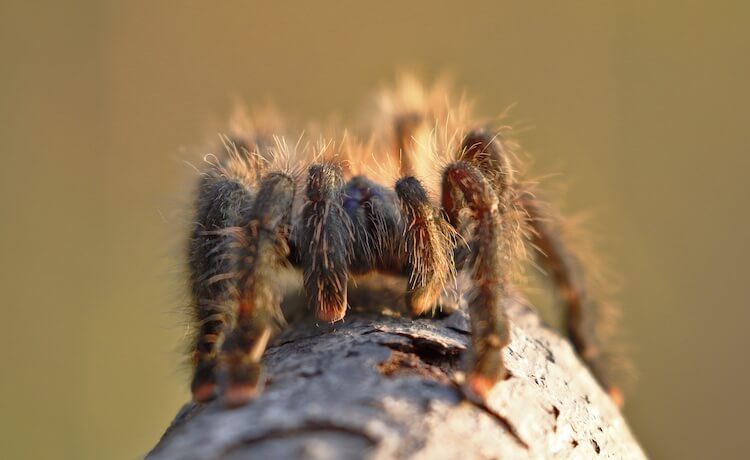
Caring for a Pink Toe will not require much work.
Instead you will want to perform routine checkups on their well-being and health. This includes ensuring proper humidity, water, food and substrate.
Owners must know their spider’s needs so they can properly care for it. If you have owned a pet spider before, and enjoyed the husbandry, then you will likely do well with a pinktoe tarantula.
Pink Toe Tarantulas are carnivorous predators. They typically feed on small invertebrates such as crickets, ants, beetles and worms. Once they are adults, they can also eat larger insects, small reptiles, and amphibians.
Most keepers often feed their pet tarantulas: roaches, mealworms, superworms and crickets:
- Juveniles should be fed small sized crickets and roaches every 2 to 3 days.
- Adults should be fed every 3 to 10 days, but can easily go on long periods without eating.
Pink-toed tarantulas should be fed live prey which they can hunt in their enclosure. Prey can be carefully placed into the enclosure. Crickets and roaches are the most common meal choices and should be fed in portions of four to six. They do not need to take any supplements (e.g. calcium).
Tarantulas will often kill their prey with their fangs, then wait to eat them.
Pink Toes are an arboreal species, so they can hunt and spin webs while in a tree. They are capable of even jumping short distances and moving quickly up trees. These abilities allow them to ambush predators of other small invertebrates.
Habitat
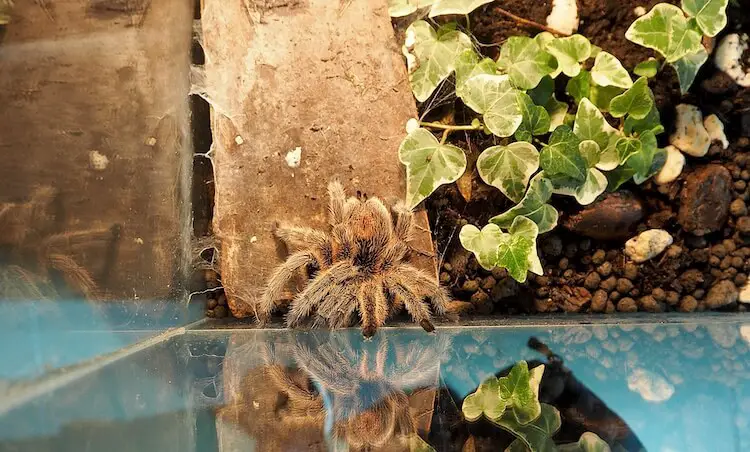
Pink Toe Tarantulas live in the jungles and forests of South and Central America. This region is shaded, humid and very warm throughout the year.
Most tarantulas are ground dwellers, but Pink-Toed tarantulas are arboreal, and only spend a small portion of its time on the ground. This allows them to move between the forest floor and trees. They are able to hunt and travel in the forest canopy and ground by spinning their webs along branches.
Their enclosure should replicate the conditions of their native habitat.
The enclosure itself should open from the side and be taller than it is wide. This vertical habitat will allow your Pink Toe Tarantula to climb.
As a rule of thumb, the tank should be at least 3x your spider’s leg span tall and 2x wide.
For example, an adult female that measures five inches will need an enclosure 15 inches tall and 10 inches wide. This is the minimum recommended size, a larger enclosure is better. There are many reptile terrariums that work well for spiders.
Coconut husk, peat moss, and reptile bark are great substrate choices to line the bottom of the tank. These substrates match those of jungle conditions and should be two inches deep.
A coconut cave, half log, rock cave all are great options to be placed in the tank.
Logs, branches, sticks and vines are also needed in the enclosure. They provide climbing material and match the tarantula’s natural habitat.
A water dish and cross ventilation can be used to help maintain humidity. But, this bowl should not be large or deep enough for your tarantula to get stuck in. It should be smaller than their body and shallower than their height, but large enough for them to sit over it and submerge their fangs.
Lighting is not required for any species of Tarantula, pink toe included. However, a red or green led bulb makes it easier to watch them.
Tarantulas do not need vitamin D3 or direct heat from light, so ceramic bulbs are not needed. Heat pads can be placed under the tank for ground and provide belly heat. A 4 Watt pad (4” x 5”) will work well to keep the temperature between 78 and 82 degrees Fahrenheit.
Lifespan
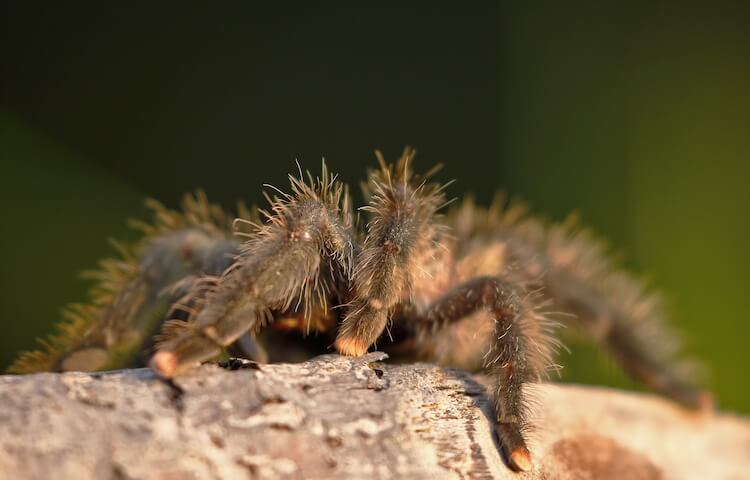
Pink Toe Tarantulas can live in captivity for up to 10 years, most live between four to eight years. Gender, size, habitat, husbandry and diet will all alter their lifespan.
Health issues generally happen as a result of poor care, diet or tank setup.
Tarantulas must have water available at all times. Without water they will quickly dehydrate and become shriveled in appearance.
Illnesses can also be caused by parasites. These can include nematode worms and mites which can make your tarantula sick. Parasites can come from unsanitary prey, wild-caught prey or a dirty tank. You should clean their tank weekly and do not feed wild caught prey.
Watch for changes in behavior but keep in mind that they can easily forego eating for weeks and may not always move around.
Molting
Inactivity and refusal to eat can be a sign of molting. However, if these symptoms happen for a period longer than two days, they are signs of health problems.
Molting is like shedding in reptiles. It is the process where a spider sheds its exoskeleton. Once the tarantula is ready to molt, it will flip onto its back to shed its old exoskeleton.
The molting process only takes a few hours, but a tarantula is affected over 48 hours due to the energy required to molt.
To avoid general health problems always check on your tarantulas behavior, ensure they have a clean enclosure, refill fresh water and feed them appropriately.
How Big Does A Pink Toe Tarantula Get?
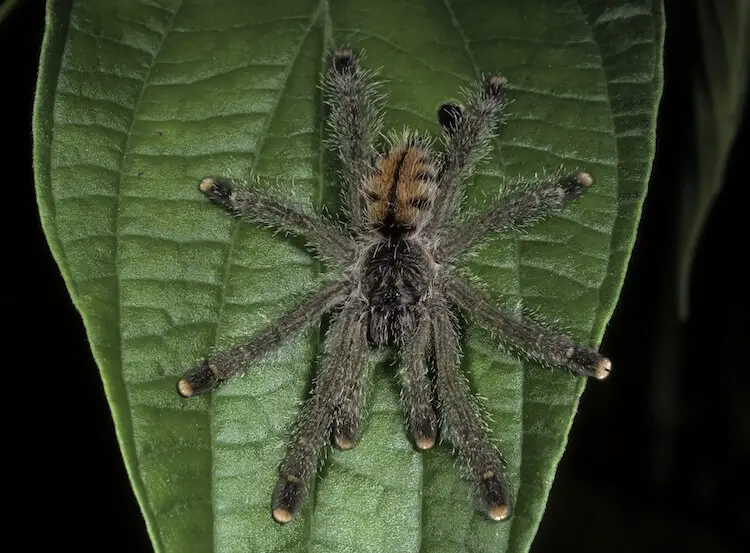
All tarantulas have a bulky body with thick legs. Pink Toes will grow to a size of between 3.5 to 5 inches, some even reach six inches. Males do not grow as large as females and are closer to 3.5 inches.
Juveniles and sling tarantulas are typically sold between 1 to 2 inches wide, smaller if they are just hatched.
As they grow from a hatchling to a juvenile their weight will increase from 3 grams to a large 30 gram adult.
The Pink Toe Tarantula has a body masked with dark hairs for protection. These hairs make them appear bulky and thicker than most spiders. Additionally, these hairs are very sensitive and can detect vibrations from nearby movements.
Their color comes from the hairs covering their body. Most tarantula are light brown to black.
Pink Toes are typically all-black with pink toe hairs.
Pink Toe Tarantulas are different from other tarantulas due to their hair. They have more hairs than most and their color can range from pink to orange. The pedipalps, toes and legs are all pink/peach. In some morphs the whole legs can be pink (e.g. Metallic morph).
This color pattern helps them to camouflage amongst the Amazon Rainforest’s dark forest leaf litter.
How To Sex A Pink Toe Tarantula?
A tarantulas sex can easily be determined by observing their most recent molt.
Start by gently picking up the molt, then flip it over to see the bottom of the abdomen.
Carefully look at the inside of this part of the molt.
Females’ molts will have two white areas on either side of the abdomen. These white areas are meant to store sperm. If you cannot see these white areas then you have a male.
Activity
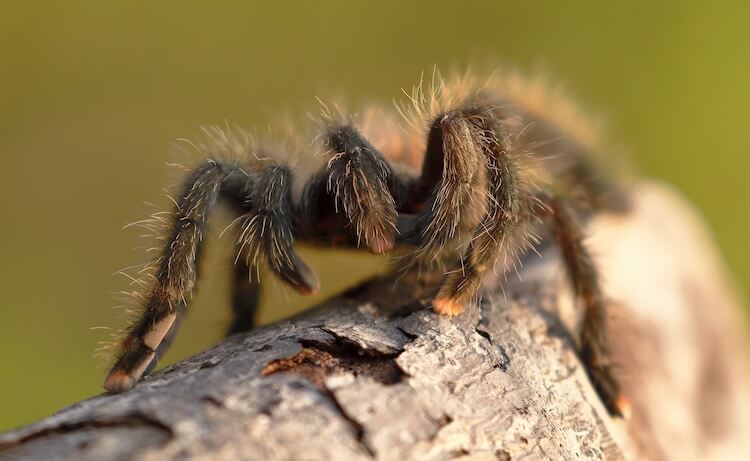
Pink Toe Tarantulas shelter in webs or under natural cover when they are molting or resting. In captivity tarantulas can be shy and may seek cover. This is a natural behavior and will reduce as they become more confident.
Their calm and docile behavior is one of the reasons they are so popular.
They are not social animals and rarely live together.
If two tarantulas are kept together they may compete for food and hides or shelters. It is possible that two will fight and kill one another. Females can easily kill males and will be territorial if males are introduced. They should not be housed together.
Tarantulas will show dominance by raising their abdomens and marching around their enclosure.
Aggressive behaviors include posturing and hair detachment.
The hairs covering Pink Toe Tarantulas can be detached into a predator. This causes skin irritation and a burning sensation. Aggressive posturing is shown when the tarantula displays raised forelegs and exposed fangs. This behavior must be respected.
Do not handle your tarantula if you see this behavior.
Experienced keepers can handle a tarantula. However. pink toe tarantulas have fragile exoskeletons that will break if they fall from a height. It is easier to use a small foam or paper box to move them.
Pink Toe Tarantula Facts
| Common Name | Pink Toe Tarantula |
|---|---|
| Scientific Name | Avicularia avicularia |
| Family Name | Theraphosidae |
| Size | 3.5 – 5 inches |
| Lifespan | 4 – 10 years |
| Price | $30 – $100 |
| Tank Size | 5-gallon |
| Range | South, Central American Rainforests |
| Similar Species | Rose Hair and Curly Hair Tarantula |
Breeders
Pink Toe Tarantulas should only be purchased from verified captive breeders either online or in person. This ensures the health and legality of the tarantula you purchase.
Some vendors attempt to catch and sell wild-caught tarantulas, this is illegal, dangerous and cruel.
Wild-caught species are taken from their natural habitat and sold without having grown up in human care.
It is common for them to be much more aggressive and harbor unknown injuries and parasites. Many species even die much younger from stress. It is best to buy a captive-bred tarantula.
Prices range from $30 to $100 for pink toe tarantulas.
Look for tarantulas that are active in the enclosure and have a full covering of hairs. Dull and inactive individuals are likely unhealthy and should not be purchased.
Summary
Pink Toe Tarantulas are a species of Tarantula with pink or orange colored toes.
They make great first-time spiders because of their shy and docile personality.
Caring for a Pink Toe does not require much work. They have very simple care needs which make them the best choice for an owner’s first tarantula. They can be kept in a small 10-gallon tank and do not need any extra lighting or heating.
Know the facts and care requirements before purchasing this spider.
They are low-cost and low-maintenance, but must be cared for with respect and patience. They have a mildly venomous bite and defensive hairs that can irritate your skin.
Let us know what you think about these and unique tarantulas below.

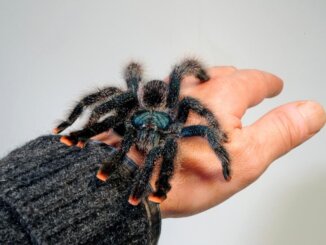
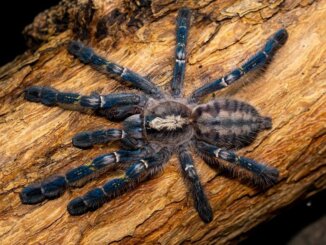
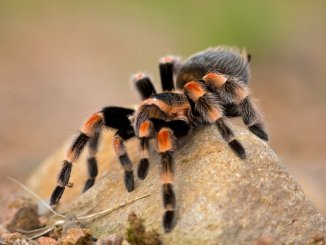

I just got my first Pink Toed Tarantula today and I have had a tarantula in the past. They make good pets.
I have a few questions. How often should I clean the tank, and will a 4.5 gallon tank work. if not, what tank is recommended for care?
The tank should be taller than it’s wider. A recommended very minimum size would be 10×15 inches, but a bigger tank will only be better and more pleasant to the Tarantula.
You should clean it weekly or every 10 days.
I have my first pet tarantula it been 23 days since I got her and I’m doin very good job taking care of her and I name her cruella
I am going to try to be nice but… there is a lot wrong with this. like… a ton. spreading incorrect information will likely mean the death/serious illness of whatever tarantula is owned by whomever reads this post. I know it’s from last year and you appear to be more about reptiles (in which case I very much hope that you are more knowledgeable with them) but yeah.. if you would like information, I imagine you can reply to this or something. 😊
Hi Dylan. We’ve made a few updates to the article but if you still see some issues or anything inaccurate, please let me know and I will verify and fix any inaccuracies.